Size matters in rural residential areas: Planning and Environment Court of Queensland dismisses an appeal in respect of a reconfiguring a lot application in Tallai on the Gold Coast
By Krystal Cunningham-Foran and Victoria Knesl
Planning and Environment Court of Queensland has dismissed an appeal against the refusal of a development application for a development permit for reconfiguring a lot into two lots.
In brief
The case of Casinco Pty Ltd v Council of the City of Gold Coast [2022] QPEC 50 concerned an appeal by Casinco Pty Ltd (Applicant) to the Planning and Environment Court of Queensland (Court) against the decision of the Council of the City of Gold Coast (Council) to refuse an impact assessable development application for reconfiguring a lot into two lots (Development Application) on land at Tallai, on the Gold Coast (Subject Site). The proposed lots are half of the minimum average lot size stated in the Gold Coast City Plan 2016 (Version 8) (Planning Scheme) for the Subject Site and half of the size of most of the other properties in the local area.
The Court considered the following issues to determine the appeal (at [7]):
-
"[W]hether the [Development Application] is consistent with reasonable community expectations for the land.
-
[W]hether the [Development Application] would compromise and disrupt the subdivision pattern of the local area.
-
[W]hether the [Development Application] results in any adverse planning consequences or amenity impacts.
-
[W]hether the [Development Application] is consistent with the draft amendments (Major Update 2 and 3) of the [Planning Scheme] to the extent relevant."
The Court held that the size of the reconfigured lots did not comply with the Planning Scheme and dismissed the appeal.
Background
The Subject Site is located on the corner of Alawara Drive and Worongary Road. The proposed development includes one 4,079 m2 lot, which includes an existing house and retains access from Alawara Drive, and a second lot of 4,015 m2 with new vehicular access from Worongary Road.
The Council refused the Development Application because the proposed development does not comply with the Planning Scheme for reasons including the proposed development does not support the "lifestyle and amenity aspirations" of local residents, is inconsistent with the current and future character and amenity of the rural residential area, and is not an average lot size of 8,000 m2 (at [5]).
The Applicant appealed the Council's decision to refuse the Development Application.
An appeal to the Court is by way of hearing anew under section 43 of the Planning and Environment Court Act 2016 (Qld) (PECA) and section 46 of the PECA provides that section 45 of the Planning Act 2016 (Qld) (Planning Act) applies for the Court's decision on the appeal as if the Court were the assessment manager for the Development Application.
Subject Site and its surrounds
The Subject Site has an area of 8,094 m2 and is in the rural residential area of Tallai where the majority of properties are 8,000 m2 or larger. Access to the Subject Site is limited because Alawara Drive is a cul-de-sac from Worongary Road, and therefore provides the only access to a "bounded area" made up of 56 lots which form part of an estate created many years ago (see [1] and [2]). Being a corner lot, the Subject Site is more visible than neighbouring lots in the area.
The Planning Scheme provides in Performance Outcome PO7 of the Rural Residential Zone Code (Zone Code) that the "[a]verage lot size is no less than 8,000m2 and no lots have an area less than 4,000m2" (Minimum Lot Size Requirement). The joint expert report of the town planning experts noted that three properties in the local area do not meet the Minimum Lot Size Requirement, one of which was created in 1967 before there was a rural residential area (see [28] to [29]).
Relevant assessment benchmarks
The relevant assessment benchmarks in the Strategic Framework of the Planning Scheme promote in the rural residential area development of a "…very low intensity and low-rise environment…with a semi-rural landscape character and protected natural features. They are not expanded.", that "…continue[s] to support the lifestyle and amenity aspirations of residents in a semi-rural or bushland environment on very low intensity lots. They are not part of the urban area", and that "…is cognisant of the function and designed future appearance of each individual area and reinforces the character of that area" (see [33] and Strategic Outcomes 3.3.1(15), 3.3.7.1(1), and 3.8.3.1(1) of the Strategic Framework).
The Minimum Lot Size Requirement and the following Overall Outcomes (OO) of the Zone Code were also relevant to the Court's consideration of the issues (at [35]):
-
OO2(b) ‒ "Character consists of: (i) Very low intensity and low-rise environments; and (ii) private acreage or bushland living, typically situated along natural landscape settings like ridgelines or valleys with the intention of being separated from urban services and providing a high amenity lifestyle choice."
-
OO2(d) ‒ "Lot design: (i) results in lots sizes and dimensions appropriate for the large lot residential locality that recognise the site's inherent values, constraints and character and supports very low density; (ii) provides an average lot size of no less than 8,000m2 to protect local amenity and character. To respond to the various constraints in the zone the lots sizes may vary provided that no lot has an area less than 4,000m2…"
Court finds inconsistency with the Planning Scheme
The Court held that the proposed development does not meet the relevant assessment benchmarks in the Planning Scheme for the following reasons:
-
The proposed development is inconsistent with the reasonable community expectations of residents of the local area as informed by the submissions objecting to the proposed development, is contrary to the spacious character of the local area, and "…would visibly intensify development…" (see [72] to [74] and [92]).
-
The Court preferred the evidence of the Council's town planning expert that the Planning Scheme requires "very low intensity" development to protect the local amenity and character of the area (at [39]).
-
The Subject Site is at the gateway or entrance of the "bounded area" of Alawara Drive and therefore contributes more to the local character and amenity of the local area than other properties, for example, properties towards the end of the cul-de-sac (at [87]).
-
The proposed development would compromise and disrupt the subdivision pattern of the local area because it does not comply with the Minimum Lot Size Requirement and it would be unreasonable to divide a lot, which just meets the Minimum Lot Size Requirement, into two lots where there is no balancing public need for the development (see [88] to [90]).
-
Whilst the Minimum Lot Size Requirement is not absolute because a lot may be designed to continue to protect the local amenity and character, the Court held that the proposed development does not protect the local amenity and character (see [88] and [91]).
-
The proposed changes in the draft amendments to the Planning Scheme, if adopted, would not significantly change the planning context of the existing Planning Scheme (at [32]).
Conclusion
The Court upheld the Council's decision to refuse the Development Application and dismissed the appeal.

